BY: MORGAN REASE
Rice is a staple food across the globe, and has been so for millennia. I’ve personally been eating rice my whole life. Generations upon generations have cooked rice before me. Yet here I am, in my apartment’s narrow galley kitchen, staring at yet another pot of bad rice. Somehow, my rice is both mushy and crunchy. My rice is a big steaming pile of disappointment. And I’m not even bad at cooking – I’ve been cooking for my whole life! For some reason though, ever since I moved into this apartment 12 months ago, I have not been able to cook good rice.
What is wrong with me? I add rice and water to the pot just like the directions state; I cook it like mom taught me to, and it still ends in failure. This sucks! So like any science-minded cook would, I decided to remedy my rice situation by re-learning the basic principles of starch chemistry. I want to know, down to the molecular level, what makes good rice good and my rice not good.

Actual photo of me holding rice after losing my ability to rice-bend https://giphy.com/search/zuko
What is rice anyway?
Rice as most of us know it today comes from a grass plant native to Asia, Oryza sativa, (Manaois). There is another species of rice endemic to Africa, Oryza glabberima, but it does not have the same global presence as O. sativa (4). Additionally, there are other species, even other genuses, that we call rice – but O. sativa is far and away the most common.
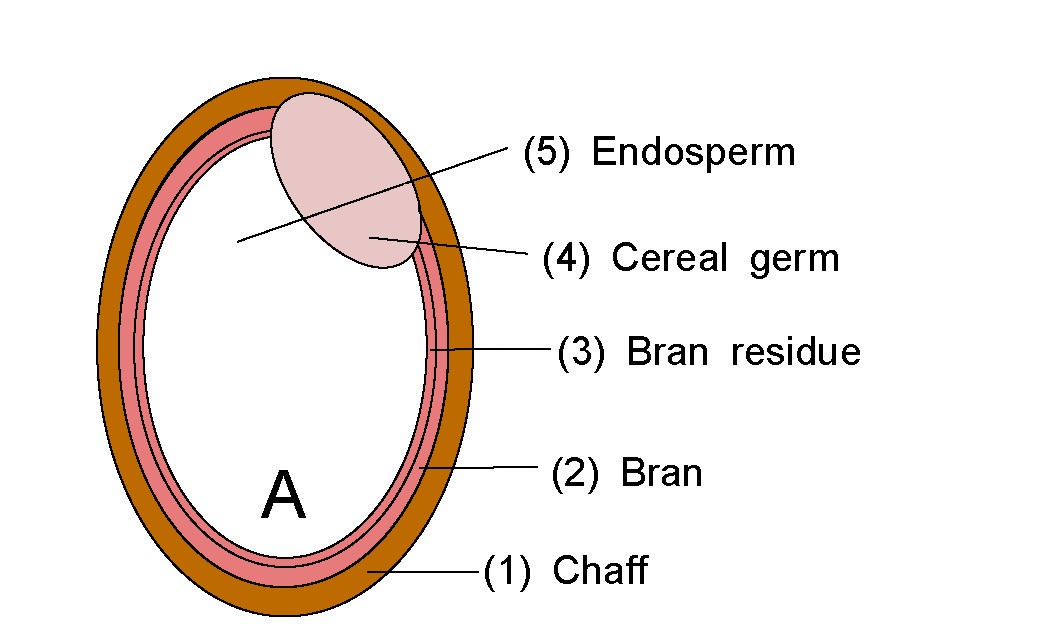
https://en.wikipedia.org/wiki/File:Rice_Animation.gif
Regardless of species, the actual grain that we eat is comprised of many layers. The outermost layer, the chaff, is tough and inedible. The chaff is removed during processing, and inside the chaff there is the bran, germ, and endosperm. It is these 3 layers that make up brown rice. The bran is the fibrous layer directly under the chaff. There is also the germ, a nutrient dense section of the grain that would become a new plant if it were allowed to sprout. White rice is just the endosperm layer, and it is almost entirely made of starch (3).
The bran and germ are nutrient dense, but not everyone enjoys the texture and flavor they provide. Additionally, they contain unsaturated fats which oxidize easily and shorten the shelf life of the rice.
Why does rice get soft when cooked?
Rice goes from crunchy dryness to pillowy goodness via a chemical process called gelatinization.
Starch, in its native state, exists as partially crystalline granules. These granules vary in shape and size depending on what they come from (potato, corn, rice, etc). Relative to other starches, rice starch granules are actually quite small. Rice starch is comprised of a mixture of two types of starch: amylose and amylopectin. Both amylose and amylopectin are large carbohydrate polymers made of glucose molecules. The difference between them is that amylose is a straight chain, while amylopectin has lots of branches (5). That structural difference has a big impact on how the starch functions, as we’ll learn soon.

amylose-https://en.wikipedia.org/wiki/Amylose
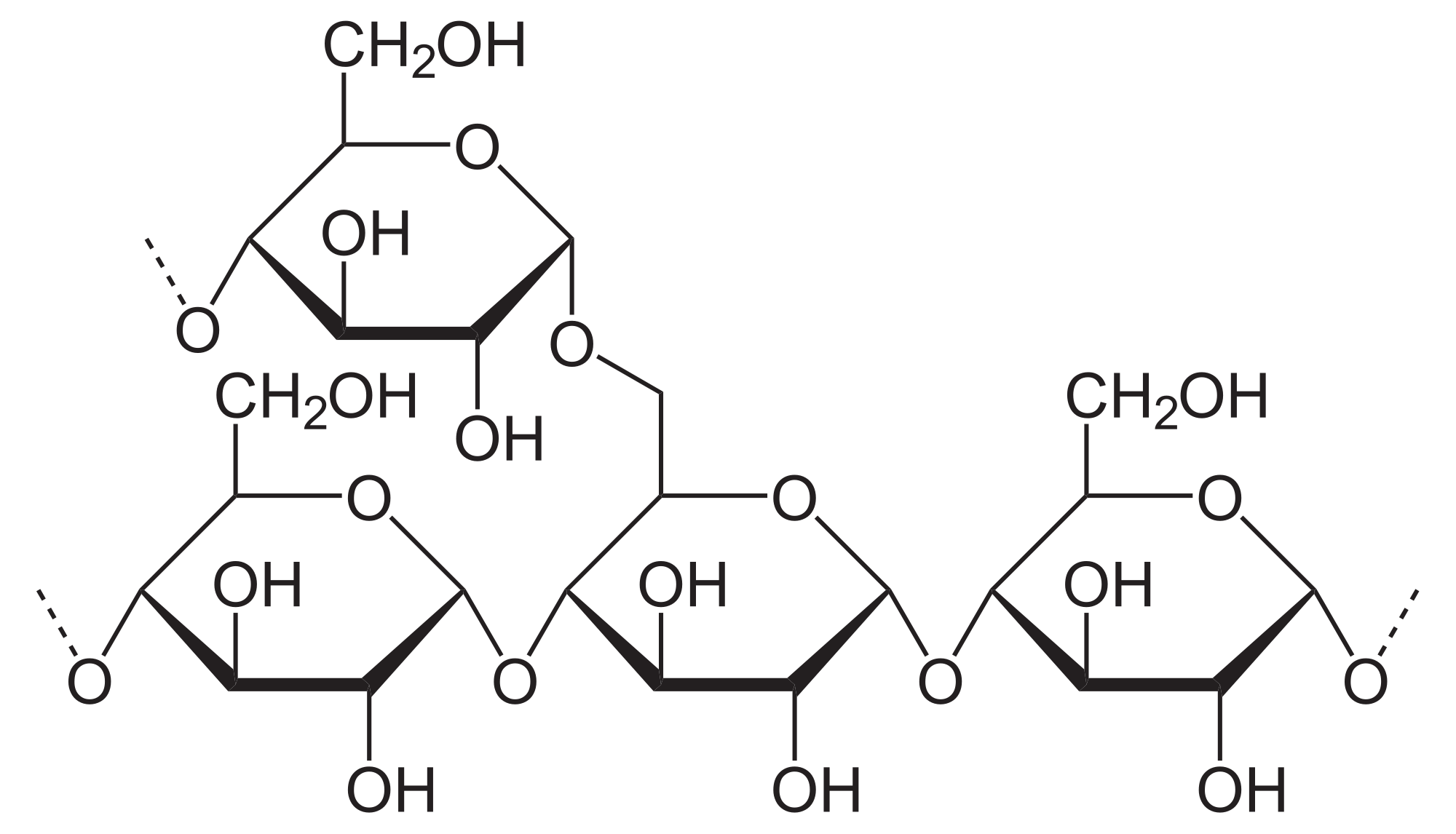
amylopectin-https://en.wikipedia.org/wiki/Amylopectin
Gelatinization is a chemical process during which the starch granules absorb a bunch of water and lose their crystallinity. Gelatinization will only occur when heat and moisture are present. A technical term for when gelatinization is effectively complete is the gelatinization temperature. The gelatinization temperature of a starch is the temperature at which 90% of starch granules have irreversibly swollen (Manaois). If rice has not been fully gelatinized, it will be hard and feel crunchy – aka it’s undercooked.
But wait! There’s more. A second process, pasting, occurs after gelatinization. Continued heating of starch after it has gelatinized, especially if the starch is physically agitated (eg if you’re stirring it), will break down the swollen granules. Broken granules leach out amylose and other molecular bits into the water around them, resulting in increased viscosity of the surrounding liquid (Manaois). Rice that has gone through extensive pasting will feel mushy and goopy – aka it has been overcooked.
Troubleshooting (My) Bad Rice
Now that we have some basic rice science under our belts, these are the factors that impact gelatinization introduced in the order of my blaming them for my bad rice:
“This new brand of rice sucks!” – Differences in rice texture by varietal
OK, so the brand of rice isn’t necessarily important, but what does matter is the variety of rice. Are you trying to cook short grain or long grain? Generally, the higher the proportion of amylose, the more water it takes to cook the grain and the firmer the final product is. Long grain rices tend to have higher amylose contents, hence they need more water to cook than short grain rices do, and the final product is firmer and less sticky than short grain rice (Manaois). See the table below for various kinds of rice and this helpful guide from Fine Cooking for how to cook them.

Table 1. Rice texture differences by varietal
“The water in this city sucks!” – How Dissolved Substances Impact Rice Quality
Remember back to the beginning of my post, how I had just moved. First thing I learned here is that I actually get water from the same source as the house I learned to cook in. So my bad rice is not because of the water. However, even if water is not the reason I cannot cook rice, it’s good to know that things in the water can make a big difference.
Tap water varies by region in its pH, and “hardness”, which is really dissolved ions. Basic pH promotes the swelling of starch while acidic pH reduces viscosity of starches, meaning that under acidic conditions the rice will feel much softer (5, 6). Too high of pH of your cooking water can actually mess with the rice pretty badly too. I cooked rice in acidified water, tap water, and alkalized water in order to illustrate the pH effects on your final rice product. The water from your tap is unlikely to be as acidic or as basic as I made mine (by adding vinegar or baking soda), so this exercise was to look at fairly extreme conditions. The acidic rice was soft and sticky, with an acidic flavor. Not bad, but not what I’d want to eat with dinner necessarily. The tap water rice turned out great! It was firm, yet soft and chewy. The alkaline rice erupted out of the rice cooker for some reason. The rice that survived was very firm, but not crunchy like uncooked rice, just very firm. It tasted strongly of soap, with a bitter sulfury aftertaste-. and weirdest of all, it came out yellow!
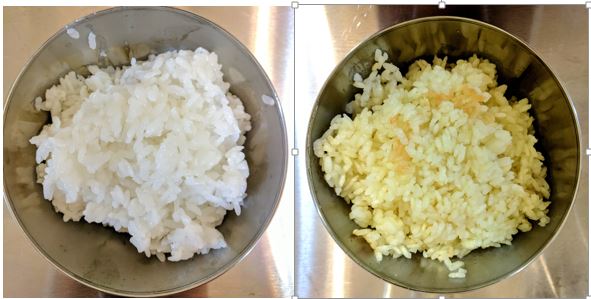
Left: short grain, white rice cooked in tap water. Right: short grain, white rice cooked in water with baking soda to raise to an alkaline pH
It’s common practice to cook in salted water, but it’s not always done that way. If you are a salted water kind of person (which you should be), the salt in your water reduces the gelation temperature of rice starch.
These other substances are less likely to be in your water, but maybe you like to experiment in the kitchen. Cooking in milk and syrup may seem like a good idea…for reasons known only to you. Sugars, such as sucrose, in your cooking water will increase the gelatinization temperature of starches, so they would need to cook to a higher temperature to achieve the same level of gelation. The sugar also competes with the starch for water, effectively reducing the amount of water available to gelatinize the starch. Fats delay the swelling of starch, meaning it may take longer to gelatinize rice cooked with fat than in a fat-free environment. Charged amino acids (I don’t know why they’re in there. You’re the weirdo adding protein powder to rice) increase the gelation temperature and the pasting temperature of your rice (Manaois, 5).
“This pot sucks!” – Managing Evaporation Rate
I’ve been cooking with some dirt-cheap, 3-pack IKEA pots that don’t have lids and have the kind of handles that are just loose enough to feel like they could fall off at any second. Real high quality stuff. I’ve been trying to macgyver my pot a lid from large mixing bowls and aluminum foil, but I don’t think it’s working. A lid is important because without a lid, water will evaporate faster, so water might boil off before the rice is finished cooking. Without a lid, you may also dry out the top layer. However, you can cook rice without a lid, you just need to be conscious of the difference in liquid needed between cooking lid on vs lid off. No lid = more water needed.
“This stove sucks!” – Cooking Temperature
As we’ve established already, cooking temperature is very important to rice quality, but with something cooked in boiling water the temperature will be pretty close to 212°F/100°C for the duration of cooking. If you don’t get the water hot enough, you may not gelatinize the starch. Keeping the pot on a very hot flame can boil off the water too quickly, which also won’t give the rice adequate time to do its thing. This is why rice is typically cooked on low heat. The easiest way to remove the stove temperature as a factor is to buy a rice cooker. If you don’t own one yet, you really should get one – it helped me a lot!
At this point I had fixed my own rice issues, but I was still unclear on some of the recommended techniques for preparing rice. So I kept learning.
Common rice practices (and why you do them)
Rinsing
Rinsing rice removes some of the excess starch on the surface of the rice. With varieties like basmati, where you want rice that doesn’t clump together, rinsing is a good idea. However, if you buy enriched rice you’ll want to be careful because rinsing rice will also rinse away a lot of the nutrients which had been sprayed onto the rice.
Soaking
Soaking rice allows rice starch to start swelling without the application of any heat. This swelling reduces the actual cooking time. This step is most impactful when preparing aromatic varieties of rice as a shorter cooking time means less of the aromatic compounds are volatilized, and thus lost.*
Salting
Salts decrease the gelatinization temperature (Manaois). In my own tests, I didn’t notice any noticeable difference in texture between salted and unsalted water. However, the rice I made using a 2% salt solution was waaaaaay better than the rice boiled in unsalted tap water. Henceforth, I will always salt my rice.
Stirring
Stirring the pot agitates the rice and can encourages pasting. If you stir too much, you’ll end up with goop because you’ve broken down the starch granules, releasing amylose and other molecular bits into the cooking liquid. However, stirring is important with dishes like risotto where the starch from the rice forms a creamy texture, so it really depends on what rice you’re going for.
Swapping X rice for Y rice in a recipe
Unless you’re just making plain rice, substituting one variety for another can be tricky. As many folks have learned first hand, swapping a white rice for brown rice doesn’t always end well. Feel free to try and substitute varieties if you’re feeling creative and have plenty of time, but if you’re cooking dinner for 40 people and you think you’re gonna just sub brown rice for the risotto, maybe just don’t.
Conclusion: how to make the best rice
As with so many things in life, the product of perfect rice depends on a lot of things and there is not one single answer. I’ve seen so much conflicting advice online on how to cook rice. It seems most of these apparent conflicts are due to people lumping all rice together and assuming the optimal method for cooking one rice is the same as for all kinds of rice. In reality, it depends on what you are trying to make and it depends on what you like. Hopefully you can use this article to work your own way through how to make the best rice by learning the why of common rice cooking practices.
*Cool aroma science: The popcorny aroma of basmati rice is from the chemical compound 2-acetyl-1-pyrroline. In southeast asia, rice is sometimes cooked with pandan leaves, which actually contain the same aroma compound so the rice becomes even more fragrant (7).
Did you love learning about rice? Come check out our Instagram and Facebook for more weekly blog updates, news, and food science!
References
- “About Rice.” Www.riceassociation.org.uk, The Rice Association, www.riceassociation.org.uk/content/1/1/about-rice.html.
- “Getting the Most From Your Grains.” Www.finecooking.com, www.finecooking.com/pdf/How-to-Cook-Rice-Chart.pdf.
- McGee, Harold. “Seeds.” On Food and Cooking: the Science and Lore of the Kitchen, Scribner, 2004, pp. 451–514.
- Organisation for Economic Co-operation and Development. “CONSENSUS DOCUMENT ON THE BIOLOGY OF ORYZA SATIVA (RICE).” Series on Harmonization of Regulatory Oversight in Biotechnology No. 14, 1999, www.oecd.org/env/ehs/biotrack/46815658.pdf.
- Shi, Yong-Cheng. “Starches: Structure & Functional Properties.” IFT Short Course: Formulating for Function. IFT Short Course: Formulating for Function, 24 June 2017, Las Vegas, NV.
- Velez, Diana Nieto. “Industrial Starch Selection and Demonstration.” IFT Short Course: Formulating for Function. IFT Short Course: Formulating for Function, 25 June 2017, Las Vegas, NV.
- Yahya, Faridah, et al. “The Absorption of 2-Acetyl-1-Pyrroline during Cooking of Rice (Oryza Sativa L.) with Pandan (Pandanus Amaryllifolius Roxb.) Leaves).” 11th International Congress on Engineering and Food, 2011.
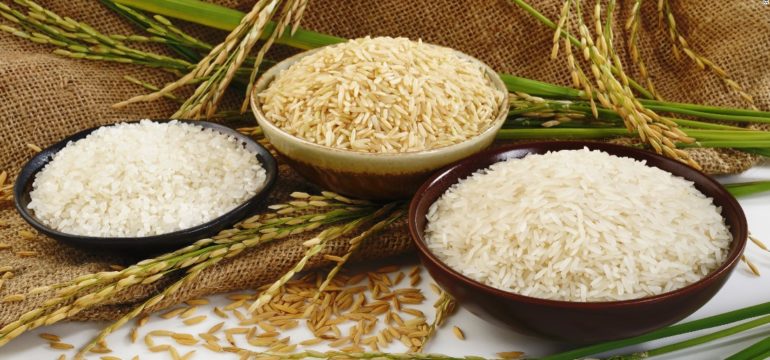

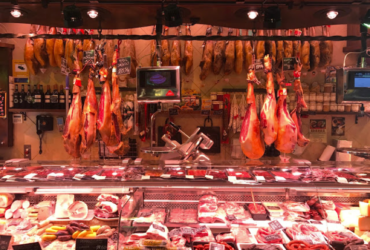
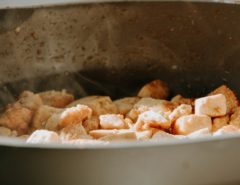
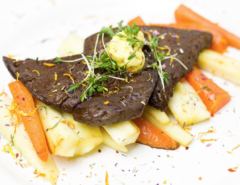

This was super useful for me and my wife the other day. We kept running into trouble with our brown rice, as it keeps coming out way stickier than it should. Oddly enough though, our tap water in Wisconsin is insanely basic, so we’ll still have to get to bottom of the problem as why it keeps coming out a little sticky even with less and less water. Thanks for the helpful tips though, Morgan!
Thank you for this generous and extensively researched post. It has given me quite a bit of food for thought. Or thought for food – hehe.